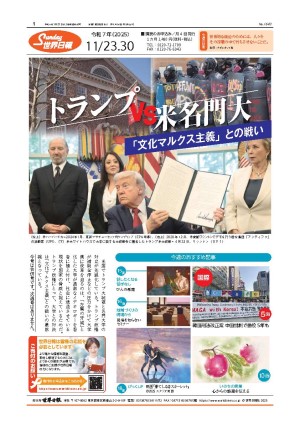WHOがウイルス命名、中国への「不名誉」回避 WHO avoids ‘stigmatizing’ China with new coronavirus name
1000人以上の死者を出した新型肺炎で、航空機の飛行が中止になり、貿易が滞っている。この肺炎を引き起こす新型コロナウイルスは「COVID―19」と命名された。「コロナウイルス」、「ディジーズ(病気)」、発見された年を合わせて付けられた。100年前のスペイン風邪のように、場所や人に病気の名称を関連付けることによる不名誉を避けるためだ。
これは今後のコロナウイルス命名の手本ともなる。最後に年を加えるだけだ。
人的被害が大きく、呼吸国難、臓器不全を引き起こすこの新たな病気をどう呼ぶかにはあまり関心が払われてこなかった。中国では何百万人もの人々が移動を許されず、4万2000人以上が感染、二十数カ国で感染が確認された。
それでも世界保健機関(WHO)は、呼び方は重要だという。共通の呼び方を持つことで科学者らの情報やデータを比較でき、インターネットにはびこる偽情報の中で社会の混乱を抑えることにもなる。
WHOのテドロス事務局長は記者団に対し「名前を付けることは、不正確であったり、名誉を傷つけたりするような呼び方を防止するために重要だ。将来発生する可能性のあるコロナウイルスについても、基準となる」と述べた。
マスコミでは、「中国からの新ウイルス」「武漢ウイルス」などの呼び方がされてきた。ウイルスが昨年12月に中国湖北省武漢で発生したからだ。
ベイラー医科大学のピーター・ホテズ教授は、COVID―19という命名は、「この病気の特徴を説明しておらず、覚えにくい」と指摘した。
「病原体の命名が不名誉かどうかを考えるよりも、いい方法があるのではないかと思う。命名によって、言及されているウイルスが何なのかを誰もが知ることができるだけでなく、発生した感染症を放置しておくことで、どれだけ健康に影響が及び、経済、世界の安全を破壊するかを後世に明確に示すこともできる」
「武漢ウイルス」という呼び方を維持すれば「命を落とした医療関係者など、勇敢に、自己の危険を顧みずこの感染症に立ち向かった武漢の人々の英雄的行動をよく示すことができる」とホテズ氏は述べている。
しかし、WHOは、地名、動物、個々の人名、組織名には触れない命名を選んだ。名称は、発音しやすく、実際の病気に関連付けられたものでなければならない。
これは、WHOが2015年に、病気の名称による、旅行、観光、動物の保護などへの「不必要な否定的な影響」を最小限にするために作成された指針に基づいている。
指針では、「レジオネラ症(在郷軍人病)」など、特定の集団に関連付けられた名前を使用しないとしている。激しい肺炎を引き起こすレジオネラ症は、1976年にフィラデルフィアで米国在郷軍人会の代表団の間で発生したことを受けて命名された。
ライム病など、地名を表す病名も使用しないとしている。ライム病は、コネティカット州の町にちなんで命名された。指針は、民族や国ではなく、患者が多い年齢、重症度、季節について短く、病気の特徴を表した用語を使用するよう求めている。
(2月11日付)
The disease that has killed more than 1,000 people in China, stopped flights and disrupted trade now has a name - “COVID-19,” a moniker that combines “coronavirus,” “disease” and the year it was discovered while averting the ignominy of tying the disease to an entire place or people, like the Spanish flu a century ago.
It also sets the table for naming future coronaviruses - just add the year at the end.
What to call the new illness has been overshadowed by the human toll of the outbreak. Millions are on lockdown in China, where more than 42,000 people have been infected, and two dozen other countries have reported the illness, which can cause respiratory distress and organ failure.
Still, the World Health Organization said a name is important. A common name helps scientists compare notes and data and heads off public confusion in a climate in which online misinformation is rampant.
“Having a name matters to prevent the use of other names that can be inaccurate or stigmatizing,” WHO Director-General Tedros Ghebreyesus told reporters. “It also gives us a standard format to use for any future coronavirus.”
Many news outlets have been referring to the illness as the “new virus from China” or “Wuhan virus,” after the Chinese city in Hubei Province where the outbreak began in December.
Peter Hotez, a professor at Baylor College of Medicine who studies diseases, said COVID-19 is not a “descriptive or memorable” name.
“Rather than thinking of naming an infectious agent as stigmatizing, potentially there’s an upside as well,” he said. “Everyone would know what virus one is referring to, but also it’s a poignant reminder of how emerging and neglected infections not only affect health but can devastate economies and global security.”
He said sticking with the “Wuhan virus” would be “a fitting tribute to the heroism of the people of Wuhan, who confronted this epidemic with bravery and selflessness, including healthcare workers who lost their lives.”
But WHO went out of its way to find a name that did not refer to a geographical location, an animal or an individual or group of people. The name also had to be pronounceable and related to the actual disease.
Those guidelines follow guidance WHO issued in 2015 to minimize the “unnecessary negative impact” of diseases named on things such as travel, tourism or animal welfare.
The guidance dispensed with names tied to specific groups such as “legionnaires’ disease,” as a type of severe pneumonia became known after a 1976 outbreak among American Legion delegates in Philadelphia.
It also said to steer away from place IDs such as Lyme disease - named for a Connecticut town - and focus on short, descriptive terms about the typical age of patients, its severity or seasonality in place of ethnicities or nationalities.
February 11, 2020





